Magmatic Material in Sandstone Shows Prospects for New Diamond Deposits within the Northern East European Platform
Abstract
1. Introduction
2. Geological Background
3. Overview of the Composition of the ADP Magmatic Rocks
4. Samples and Analytical Techniques.
4.1. Samples
4.2. Analytical Techniques
5. Petrography
6. Results
6.1. Major and Trace Element Whole-Rock Geochemistry
6.2. Morphology of Kimberlite Indicator Minerals from the KL01 Pipe
6.3. Geochemistry of Kimberlite Indicator Minerals from the KL01 Pipe
6.3.1. Garnet
6.3.2. Chromium Spinel
6.3.3. Magnesian Ilmenite
6.3.4. Olivine and Chromium Diopside
7. Discussion
7.1. Smectite Group Minerals as Kimberlite Indicators within the Arkhangelsk Diamondiferous Province
7.2. Evaluation of the Type of Magmatic Material Admixture in the KL-01 Pipe
- Step 1. Excluding the Admixture of Carbonatite and Carbonatized Kimberlite Component
- Step 2. Excluding the Admixture of the Basalt Component
- Step 3. Excluding the Admixture of Micaceous Picrite/Olivine Melilitite of the Group 2 Component
- Step 4. Choosing the Type of MM Admixture
Model Verification using the Natural Samples
7.3. The KIM Composition as the Key to Evaluating the Thermal State, Composition and Metasomatic Evolution of the Lithospheric Mantle Sampled using the KL-01 Pipe
7.3.1. Thermal State of the Lithospheric Mantle
7.3.2. Composition and Metasomatic Evolution of the Lithospheric Mantle Sampled by the KL-01 Pipe
8. Conclusions
Supplementary Materials
Funding
Data Availability Statement
Acknowledgments
Conflicts of Interest
References
- Shchukina, E.V.; Shchukin, V.S. Diamond exploration potential of the northern East European Platform. Minerals 2018, 8, 189. [Google Scholar] [CrossRef]
- Smit, K.V.; Shor, R. Geology and development of the Lomonosov diamond deposit, Northwestern Russia. Gems Gemol. 2017, 53, 144–167. [Google Scholar] [CrossRef]
- Shchukina, E.V.; Agashev, A.M.; Shchukin, V.S. Diamond-bearing root beneath the northern East European Platform (Arkhangelsk region, Russia): Evidence from Cr-pyrope trace-element geochemistry. Minerals 2019, 9, 261. [Google Scholar] [CrossRef]
- Verichev, E.M. Geological Conditions of Formation and Exploration of the V. Grib Deposit. Ph.D Thesis, M.V. Lomonosov Moscow State University, Moscow, Russia, 2002. (In Russian). [Google Scholar]
- Korotkov, Y.V. Search for Hidden Kimberlite Bodies Using Pulsed Inductive Electrical Prospecting in the Arkhangelsk Diamondiferous Province. Ph.D Thesis, Arkhangelsk Institute of Ecological Problems of the North, Arkhangelsk, Russia, 2012. (In Russian). [Google Scholar]
- Stogniy, V.V.; Korotkov, Y.V. Search for Kimberlite Bodies by the Method of Transitional Processes; Publishing House “Small Circulation Printing 2D”: Novosibirsk, Russia, 2010; p. 121. (In Russian) [Google Scholar]
- Zinchuk, N.N. Specific features of typical models of kimberlite pipes and their use in diamond prospecting. Vestn. Voronezh State Univ. 2011, 1, 133–144. (In Russian) [Google Scholar]
- Shevchenko, S.S.; Lokhov, K.I.; Sergeev, S.A. Isotope studies in VSEGEI. Prospects of application of results for predicting and search of diamond deposits. In Proceedings of the Scientific Practical Conference on Efficiency of Prediction and Search for Diamond Deposits: Past, Present, and Future, Saint-Petersburg, Russia, 25–27 May 2004; pp. 383–387. [Google Scholar]
- Bogatikov, O.A.; Garanin, V.K.; Kononova, V.A.; Kudryavceva, G.P.; Vasil’eva, E.R.; Verzhak, V.V.; Verichev, E.M.; Parsadanyan, K.S.; Posuhova, T.V. Arkhangelsk Diamondiferous Province; Moscow State University: Moscow, Russia, 1999; p. 521, (In Russian). ISBN 5-211-02558-X. [Google Scholar]
- Golovin, N.N. Geological Structure, Mineral Composition and Formation Conditions of Alkaline-Ultra-Basic Rocks of the Kepino Field (Arkhangelsk Diamondiferous Province). Ph.D Thesis, M.V. Lomonosov Moscow State University, Moscow, Russia, 2003. (In Russian). [Google Scholar]
- Garanin, K.V. Alkaline Ultramafic Magmatites of the Zimny Bereg: Their Potential Diamond Content and Prospects for Industrial Development. Ph.D Thesis, M.V. Lomonosov Moscow State University, Moscow, Russia, 2004. (In Russian). [Google Scholar]
- Shpilyaeva, D.V. Geological Structure, Mineral Composition, and Environmental Aspects of the Development of the Arkhangelskaya Pipe (the M.V. Lomonosov Diamond Deposit). Ph.D. Thesis, M.V. Lomonosov Moscow State University, Moscow, Russia, 2008. (In Russian). [Google Scholar]
- Bogatikov, O.A.; Kononova, V.A.; Nosova, A.A.; Kondrashov, I.A. Kimberlites and lamproites of the East-European Platform: Petrology and geochemistry. Petrology 2007, 15, 315–334. [Google Scholar] [CrossRef]
- Kononova, V.A.; Golubeva, Y.Y.; Bogatikov, O.A.; Kargin, A.V. Diamond resource potential of kimberlites from the Zimny Bereg field, Arkhangel’sk oblast. Geol. Ore Deposit. 2007, 49, 421–441. [Google Scholar] [CrossRef]
- Smith, C.B.; Gurney, J.J.; Skinner, E.M.W.; Clement, C.R.; Ebrahim, N. Geochemical character of Southern African kimberlites: A new approach on isotopic constraints. Trans. Geol. Soc. S. Afr. 1985, 88, 267–280. [Google Scholar]
- Lehtonen, M.; O’Brien, H.; Peltonen, P.; Kukkonen, I.; Ustinov, V.; Verzhak, V. Mantle xenocrysts from the Arkhangelskaya kimberlite (Lomonosov mine, NW Russia): Constraints on the composition and thermal state of the diamondiferous lithospheric mantle. Lithos 2009, 112, 924–933. [Google Scholar] [CrossRef]
- Beard, A.D.; Downes, H.; Hegner, E.; Sablukov, S.M. Geochemistry and mineralogy of kimberlites from the Arkhangelsk Region, NW Russia: Evidence for transitional kimberlite magma types. Lithos 2000, 51, 47–73. [Google Scholar] [CrossRef]
- Sinitsin, A.; Ermolaeva, L.; Grib, V. The Arkhangelsk diamond-kimberlite province—A recent discovery in the north of the east European platform. In Proceedings of the 5th International Kimberlite Conference, Araxa, Brazil, 18 June–4 July 1991; Companhia de Pesquisa de Recursos Minerals: Rio de Janeiro, Brazil; pp. 27–33. [Google Scholar]
- Mahotkin, I.L.; Gibson, S.A.; Thompson, R.N.; Zhuravlev, D.Z.; Zherdev, P.U. Late Devonian diamondiferous kimberlite and alkaline picrite (proto-kimberlite?) magmatism in the Arkhangelsk region, Russia. J. Petrol. 2000, 41, 201–227. [Google Scholar] [CrossRef]
- Mahotkin, I.L.; Sablukov, S.M.; Zhuravlev, D.Z.; Zherdev, P.U. Geochemistry and Sr-Nd composition of kimberlites, melilitites and basalts from the Arkhangelsk region, Russia. Int. Kimberl. Conf. Ext. Abstr. 1995, 6, 342–344. [Google Scholar]
- Golubev, Y.K.; Prusakova, N.A.; Golubeva, Y.Y. Kepino field kimberlites, Arkhangelsk region. Ores Met. 2010, 1, 38–44. (In Russian) [Google Scholar]
- Nikolaeva, I.V.; Palesskii, S.V.; Koz’menko, O.A.; Anoshin, G.N. Analysis of geologic reference materials for REE and HFSE by inductively coupled plasma-mass spectrometry (ICP-MS). Geochem. Int. 2008, 46, 1016–1022. [Google Scholar] [CrossRef]
- Korolyuk, V.N.; Lavrent’ev, Y.G.; Usova, L.V.; Nigmatulina, E.N. JXA-8100 microanalyzer: Accuracy of analysis of rock-forming minerals. Russ. Geol. Geophys. 2008, 49, 165–168. [Google Scholar] [CrossRef]
- Lavrent’ev, Y.G.; Korolyuk, V.N.; Usova, L.V.; Nigmatulina, E.N. Electron probe microanalysis of rock-forming minerals with a JXA-8100 electron probe microanalyzer. Russ. Geol. Geophys. 2015, 56, 1428–1436. [Google Scholar] [CrossRef]
- Horn, L.; Hinton, R.W.; Jackson, S.E.; Longerich, H.P. Ultra-trace element analysis of NIST SRM 616 and 614 using laser ablation microprobe-inductively coupled plasma mass spectrometry (LAM-ICP-MS): A comparison with secondary ion mass spectrometry (SIMS). Geostand. Newslett. 1997, 21, 191–203. [Google Scholar] [CrossRef]
- Whitney, D.L.; Evans, B.W. Abbreviations for names of rock-forming minerals. Am. Mineral. 2010, 95, 185–187. [Google Scholar] [CrossRef]
- Golubeva, Y.Y.; Pervov, V.A.; Kononova, V.A. Petrogenesis of Autoliths from Kimberlitic Breccias in the V. Grib Pipe (Arkhangelsk District). Dokl. Earth Sci. 2006, 411, 1257–1262. [Google Scholar] [CrossRef]
- Grütter, H.S.; Gurney, J.J.; Menzies, A.H.; Winter, F. An updated classification scheme for mantle-derived garnet, for use by diamond explorers. Lithos 2004, 77, 841–857. [Google Scholar] [CrossRef]
- Shchukina, E.V.; Agashev, A.M.; Soloshenko, N.G.; Streletskaya, M.V.; Zedgenizov, D.A. Origin of V. Grib pipe eclogites (Arkhangelsk region, NW Russia): Geochemistry, Sm-Nd and Rb-Sr isotopes and relation to regional Precambrian tectonics. Mineral. Petrol. 2019, 113, 593–612. [Google Scholar] [CrossRef]
- Sobolev, N.V.; Lavrentyev, Y.G.; Pokhilenko, N.P.; Usova, L.V. Chrome-rich garnets from the kimberlites of Yakutia and their parageneses. Contrib. Mineral. Petrol. 1973, 40, 39–52. [Google Scholar] [CrossRef]
- McDonough, W.F.; Sun, S.S. The composition of the Earth. Chem. Geol. 1995, 120, 223–253. [Google Scholar] [CrossRef]
- Shchukina, E.V.; Agashev, A.M.; Kostrovitsky, S.I.; Pokhilenko, N.P. Metasomatic processes in the lithospheric mantle beneath the V. Grib kimberlite pipe (Arkhangelsk diamondiferous province). Russ. Geol. Geophys. 2015, 56, 1701–1716. [Google Scholar] [CrossRef]
- Shchukina, E.V.; Agashev, A.M.; Pokhilenko, N.P. Metasomatic origin of garnet xenocrysts from the V. Grib kimberlite pipe, Arkhangelsk region, NW Russia. Geosci. Front. 2017, 8, 641–651. [Google Scholar] [CrossRef]
- Agashev, A.M.; Serov, I.V.; Tolstov, A.V.; Shchukina, E.V.; Ragozin, A.L.; Pokhilenko, N.P. New genetic classification of lithospheric mantle garnets. In Proceedings of the 5th Russian Scientific and Practical Conference “Efficiency of Geological Exploration for Diamonds: Prospects, Resource, Methodology and Innovative-Technological Aspects”, Mirny, Russia, 29 May–1 June 2018; pp. 338–342. (In Russian). [Google Scholar]
- Ryan, C.G.; Griffin, W.L.; Pearson, N.J. Garnet geotherms: A technique for derivation of P-T data from Cr-pyrope garnets. J. Geophys. Res. 1996, 101, 5611–5625. [Google Scholar] [CrossRef]
- Griffin, W.L.; Shee, S.R.; Ryan, C.G.; Win, T.T.; Wyatt, B.A. Harzburgite to lherzolite and back again: Metasomatic processes in ultramafic xenoliths from the Wesselton kimberlite, Kimberly, South Africa. Contrib. Mineral. Petrol. 1999, 134, 232–250. [Google Scholar] [CrossRef]
- Stachel, T.; Banas, A.; Aulbach, S.; Smit, K.V.; Wescott, P.; Chinn, I.L.; Julie Kong, J. The Victor Mine (Superior Craton, Canada): Neoproterozoic lherzolitic diamonds from a thermally-modified cratonic root. Mineral. Petrol. 2018, 112 (Suppl. 1), S325–S326. [Google Scholar] [CrossRef]
- Gibson, S.A. On the nature and origin of garnet in high-refractory Archean lithospheric mantle: Constraints from the garnet exsolved in Kaapvaal craton orthopyroxene. Mineral. Mag. 2017, 81, 781–809. [Google Scholar] [CrossRef]
- Tappert, R.; Stachel, T.; Harris, J.W.; Muehlenbachs, K.; Ludwig, T.; Brey, G.P. Diamonds from Jagersfontein (South Africa): Messengers from the sublithospheric mantle. Contrib. Mineral. Petrol. 2005, 150, 505–522. [Google Scholar] [CrossRef]
- Gregoire, M.; Bell, D.R.; Le Roex, A.P. Garnet lherzolites from the Kaapvaal craton (South Africa): Trace element evidence for a metasomatic history. J. Petrol. 2003, 44, 629–657. [Google Scholar] [CrossRef]
- Schulze, D.J. Origins of chromian and aluminous spinel macrocrysts from kimberlites in Southern Africa. Can. Mineral. 2001, 39, 361–376. [Google Scholar] [CrossRef]
- Nowicki, T.E.; Moore, R.O.; Gurney, J.; Baumgartner, M.C. Diamonds and associated heavy minerals in kimberlite: A review of key concepts and applications. In Developments in Sedimentology; Elsevier: Amsterdam, The Netherlands, 2007; Volume 58, pp. 1235–1267. [Google Scholar]
- Wyatt, B.A.; Baumgartner, M.; Anchar, E.; Grutter, H. Compositional classification of “kimberlitic” and “non-kimberlitic” ilmenite. Lithos 2004, 77, 819–840. [Google Scholar] [CrossRef]
- Kargin, A.V.; Nosova, A.A.; Sazonova, L.V.; Peresetskaya, E.V.; Golubeva, Y.Y.; Lebedeva, N.M.; Tretyachenko, V.V.; Khvostikov, V.A.; Burmii, J.P. Ilmenite from the Arkhangelsk Diamond Province, Russia: Composition, Origin and Indicator of Diamondiferous Kimberlites. Petrology 2020, 28, 315–337. [Google Scholar] [CrossRef]
- Sobolev, N.V.; Shvedenkov, G.Y.; Zinchuk, Koroluk, V.N. Nitrogen in chromite and olivine coexisting with diamond. Dokl. Acad. Nauk USSR 1989, 309, 697–701. (In Russian) [Google Scholar]
- Sablukov, S.M.; Sablukova, L.I.; Shavyrina, M.V. Mantle xenoliths from the Zimnii Bereg kimberlite deposits of rounded diamonds, Arkhangelsk diamondiferous province. Petrologia 2000, 8, 518–548. (In Russian) [Google Scholar]
- Sazonova, L.V.; Nosova, A.A.; Kargin, A.V.; Borisovskiy, S.E.; Tretyachenko, V.V.; Abazova, Z.M.; Griban, Y.G. Olivine from the Pionerskaya and V. Grib kimberlite pipes, Arkhangelsk diamond province, Russia: Types, composition, and origin. Petrology 2015, 23, 227–258. [Google Scholar] [CrossRef]
- Malkovets, V.G.; Zedgenizov, D.A.; Sobolev, N.V.; Kuzmin, D.V.; Gibsher, A.A.; Shchukina, E.V.; Golovin, N.N.; Verichev, E.M.; Pokhilenko, N.P. Contents of trace elements in olivines from diamonds and peridotite xenoliths of the V. Grib kimberlite pipe (Arkhangel’sk diamondiferous province, Russia). Dokl. Earth Sci. 2011, 436, 219–223. [Google Scholar] [CrossRef]
- Ramsey, R.R.; Tompkins, L.A. The geology, heavy mineral concentrate mineralogy, and diamond prospectivity of Boa Esperanca and Cana Verde pipes, Corrego D’anta, Minas Gerais, Brazil. In Kimberlites, Related Rocks and Mantle Xenoliths; Meyer, H.O.A., Leonardos, O.H., Eds.; Companhia de Pesquisa de Recursos Minerais: Araxá, Brazil, 1991; pp. 329–345. [Google Scholar]
- Nimis, P. Evaluation of diamond potential from the composition of peridotitic chromian diopside. Eur. J. Mineral. 1998, 10, 505–519. [Google Scholar] [CrossRef]
- Nimis, P.; Taylor, W.R. Single clinopyroxene thermobarometry for garnet peridotites. Part I. Calibration and testing of a Cr-in-Cpx barometer and an enstatite-in-Cpx thermometer. Contrib. Mineral. Petrol. 2000, 139, 541–554. [Google Scholar] [CrossRef]
- Ziberna, L.; Nimis, P.; Kuzmin, D.; Malkovets, V.G. Error sources in single-clinopyroxene thermobarometry and a mantle geotherm for the Novinka kimberlite, Yakutia. Am. Mineral. 2016, 101, 2222–2232. [Google Scholar] [CrossRef]
- Morkel, J.; Vermaak, M.K.G. The role of swelling clay in kimberlite weathering. Miner. Process. Extr. Metall. 2006, 115, 150–154. [Google Scholar] [CrossRef]
- Morkel, J.; Pistorius, P.C.; Vermaak, M.K.G. Cation exchange behaviour of kimberlite in solutions containing Cu2+ and K+. Miner. Eng. 2007, 20, 1145–1152. [Google Scholar] [CrossRef]
- Sobolev, V.K. To Study the Kimberlites of the Southeastern White Sea, Develop and Implement Methods for Their Forecasting and Assessment; Territorial Regional Geological Fund; TSNIGRI: Moscow, Russia, 1988. (In Russian) [Google Scholar]
- Zinchuk, N.N. Comparative characteristics of weathering crust composition of kimberlite rocks in the Siberian and East-European platforms. Russ. Geol. Geophys. 1992, 33, 99–109. [Google Scholar]
- Shcherbakova, T.E. Typomorphic Characteristics of Kimberlite Minerals in Pipe Halos and Their Use in Prospecting for Diamond Deposits within the Zimniy Bereg. Ph.D. Thesis, Central Research Institute of Geological Prospecting for Base and Precious Metals, Moscow, Russia, 2005. (In Russian). [Google Scholar]
- Afanasiev, V.P.; Zinchuk, N.N.; Pokhilenko, N.P. Exploration Mineralogy of Diamond; Sobolev, N.V., Mityukhin, S.I., Eds.; Academic Publishing House “Geo”: Novosibirsk, Russia, 2010; (In Russian). ISBN 978-5-9747-0180-1. [Google Scholar]
- Vasil’ev, I.D. Geological Structures Near the Arkhangelskaya Kimberlite Pipe and Their Use for Diamond Exploration within the Zimnii Bereg. Ph.D. Thesis, Sergo Ordzhonikidze Russian State University for Geological Prospecting, Moscow, Russia, 2010. (In Russian). [Google Scholar]
- Sobolev, V.K.; Koldaev, S.M.; Kolod’ko, A.A.; Levin, V.I. Method of Searching for Areas of Kimberlite. Russian. Federation Patent No. 2062493 , 20 June 1996. [Google Scholar]
- Giuliani, A.; Pearson, D.G.; Soltys, A.; Dalton, H.B.; Phillips, D.; Foley, S.F.; Lim, E.; Goemann, K.; Griffin, W.L.; Mitchell, R.H. Kimberlite genesis from a common carbonate-rich primary melt modified by lithospheric mantle assimilation. Sci. Adv. 2020, 6, eaaz0424. [Google Scholar] [CrossRef] [PubMed]
- Soltys, A.; Giuliani, A.; Phillips, D. A new approach to reconstructing the composition and evolution of kimberlite melts: A case study of the archetypal Bultfontein kimberlite (Kimberley, South Africa). Lithos 2018, 304–307, 1–15. [Google Scholar] [CrossRef]
- Kjarsgaard, B.A.; Pearson, D.G.; Tappe, S.; Nowell, G.M.; Dowall, D.P. Geochemistry of hypabyssal kimberlites from Lac de Gras, Canada: Comparisons to a global database and applications to the parent magma problem. Lithos 2009, 112, 236–248. [Google Scholar] [CrossRef]
- Afanasiev, V.P.; Ashchepkov, I.V.; Verzhak, V.V.; O’Brien, H.O.; Palessky, S.V. PT conditions and trace element variations of picroilmenites and pyropes from placers and kimberlites in the Arkhangelsk region, NW Russia. J. Asian Earth Sci. 2013, 70–71, 45–63. [Google Scholar] [CrossRef]
- Hasterok, D.; Chapman, D.S. Heat production and geotherms for the continental lithosphere. Earth Planet. Sci. Lett. 2011, 307, 59–70. [Google Scholar] [CrossRef]
- Agashev, A.M.; Ionov, D.A.; Pokhilenko, N.P.; Golovin, A.V.; Cherepanova, Yu.; Sharygin, I.S. Metasomatism in the lithospheric mantle roots: Constraints from WR and minerals chemical composition of deformed peridotite xenoliths from the Udachnaya kimberlite pipe. Lithos 2013, 160–161, 201–215. [Google Scholar] [CrossRef]
- Howarth, G.H.; Barry, P.H.; Pernet-Fisher, J.F.; Baziotis, I.P.; Pokhilenko, N.P.; Pokhilenko, L.N.; Bodnar, R.J.; Tayor, L.A.; Agashev, A.M. Superplume metasomatism: Evidence from Siberian mantle xenoliths. Lithos 2014, 184-187, 209–224. [Google Scholar] [CrossRef]
- Stachel, T.; Aulbach, S.; Brey, G.P.; Harris, J.W.; Leost, I.; Tappert, R.; Viljoen, K.S. The trace element composition of silicate inclusions in diamonds: A review. Lithos 2004, 77, 1–19. [Google Scholar] [CrossRef]
- Ziberna, L.; Nimis, P.; Zanetti, A.; Marzoli, A.; Sobolev, N.V. Metasomatic processes in the central Siberian cratonic mantle: Evidence from garnet xenocrysts from the Zagadochnaya kimberlite. J. Petrol. 2013, 54, 2379–2409. [Google Scholar] [CrossRef]
- Doucet, L.S.; Ionov, D.A.; Golovin, A.V. The origin of coarse garnet peridotites in cratonic lithosphere: New data on xenoliths from the Udachnaya kimberlite, central Siberia. Contrib. Mineral. Petrol. 2013, 165, 1225–1242. [Google Scholar] [CrossRef]
- Shu, Q.; Brey, G.P. Ancient mantle metasomatism recorded in subcalcic garnet xenocrysts: Temporal links between mantle metasomatism, diamond growth and crustal tectonomagmatism. Earth Planet. Sci. Lett. 2015, 418, 27–39. [Google Scholar] [CrossRef]
- Chepurov, A.A.; Faryad, S.W.; Agashev, A.M.; Strnad, L.; Jedlicka, R.; Turkin, A.I.; Mihaljevic, M.; Lin, V.V. Experimental crystallization of a subcalcic Cr-rich pyrope in the presence of REE-bearing carbonatite. Chem. Geol. 2019, 509, 103–114. [Google Scholar] [CrossRef]
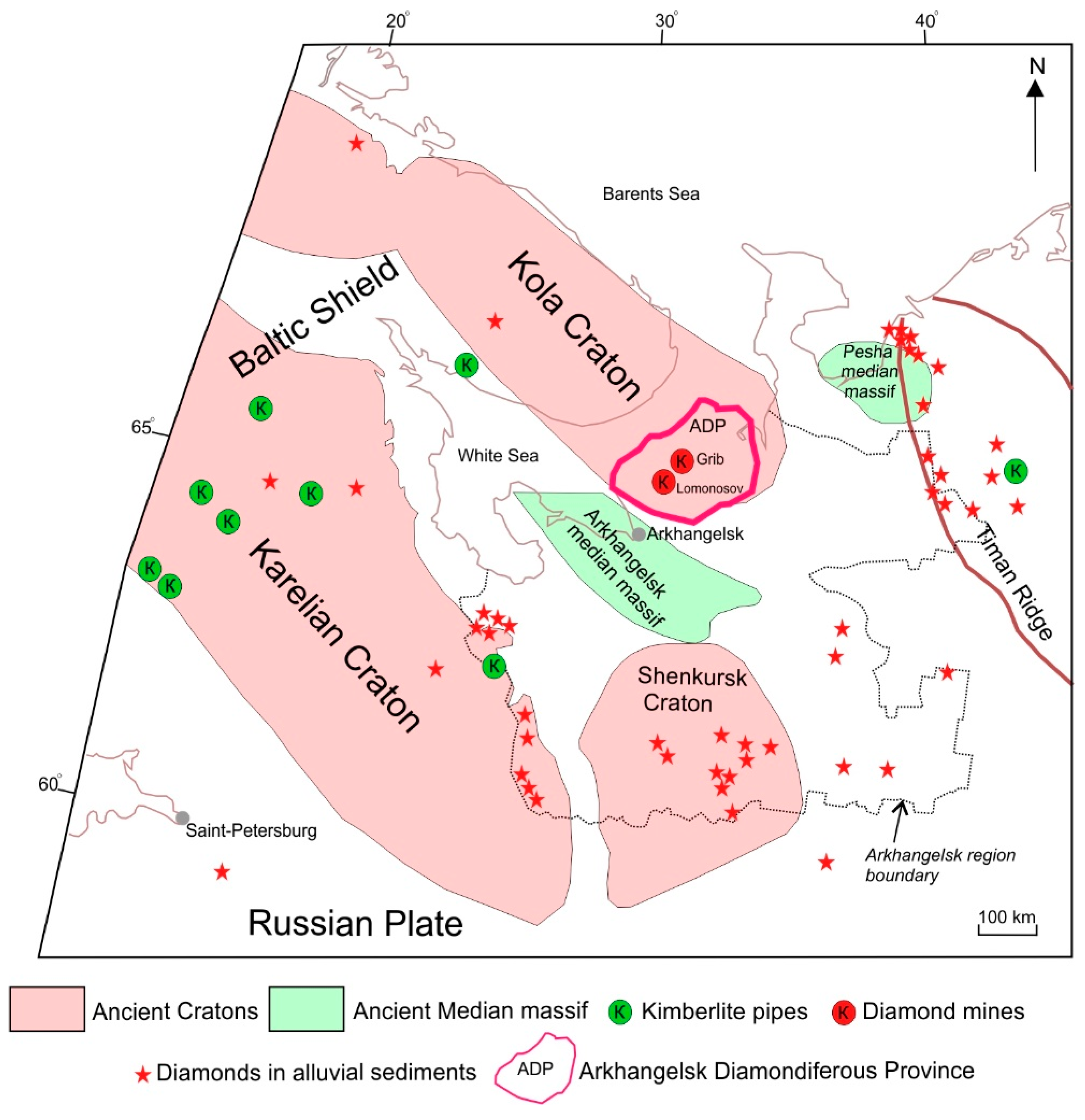
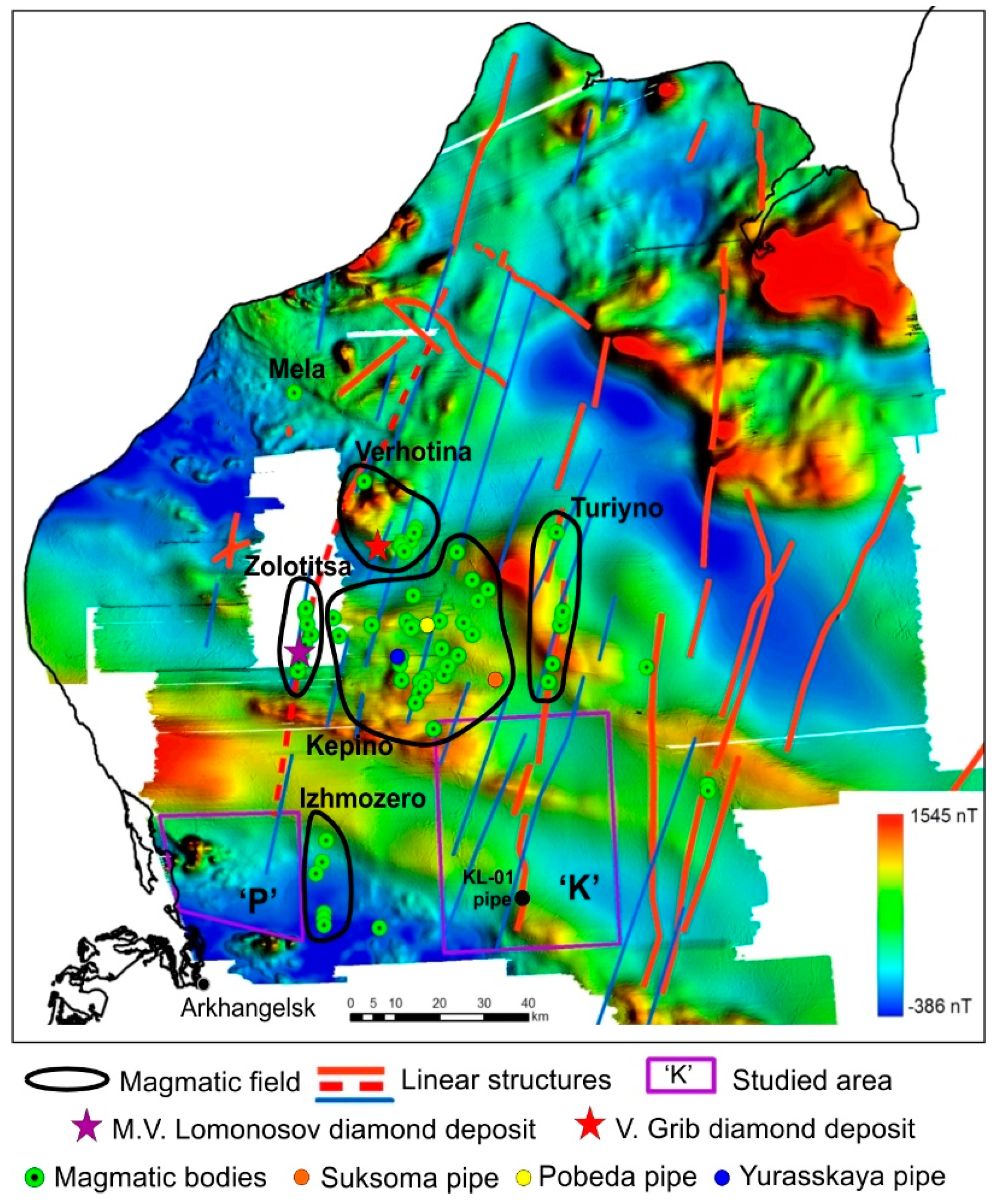
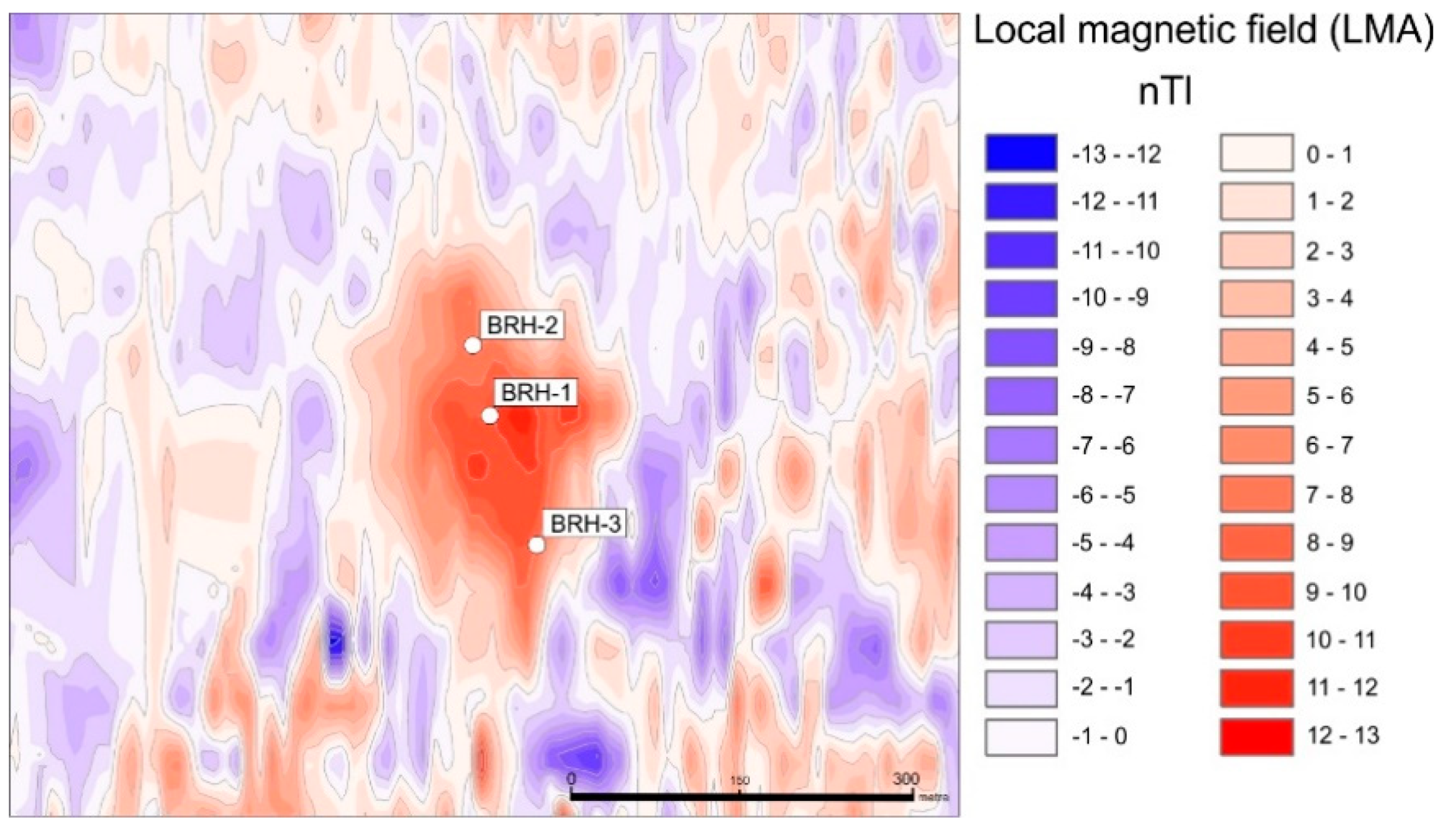
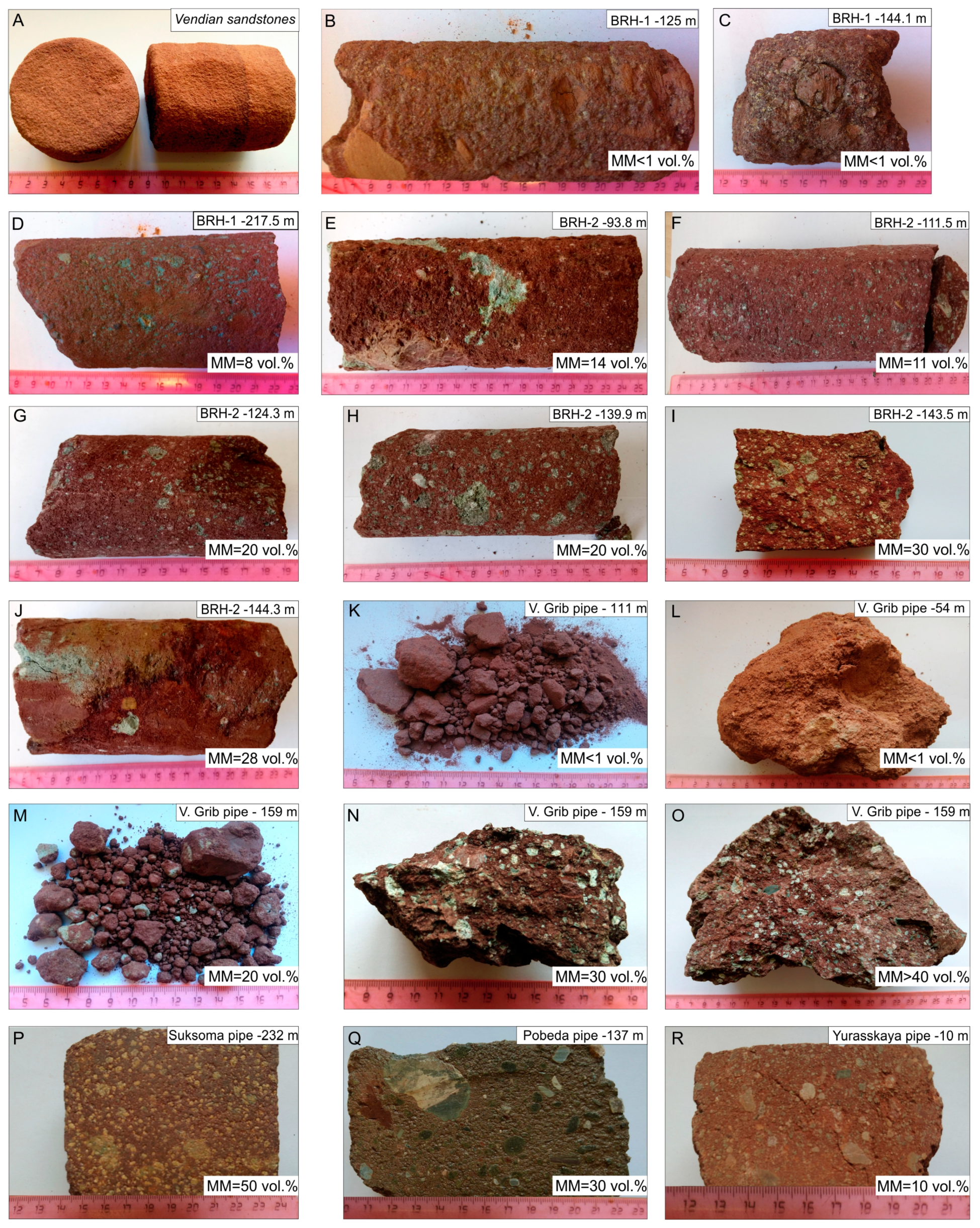

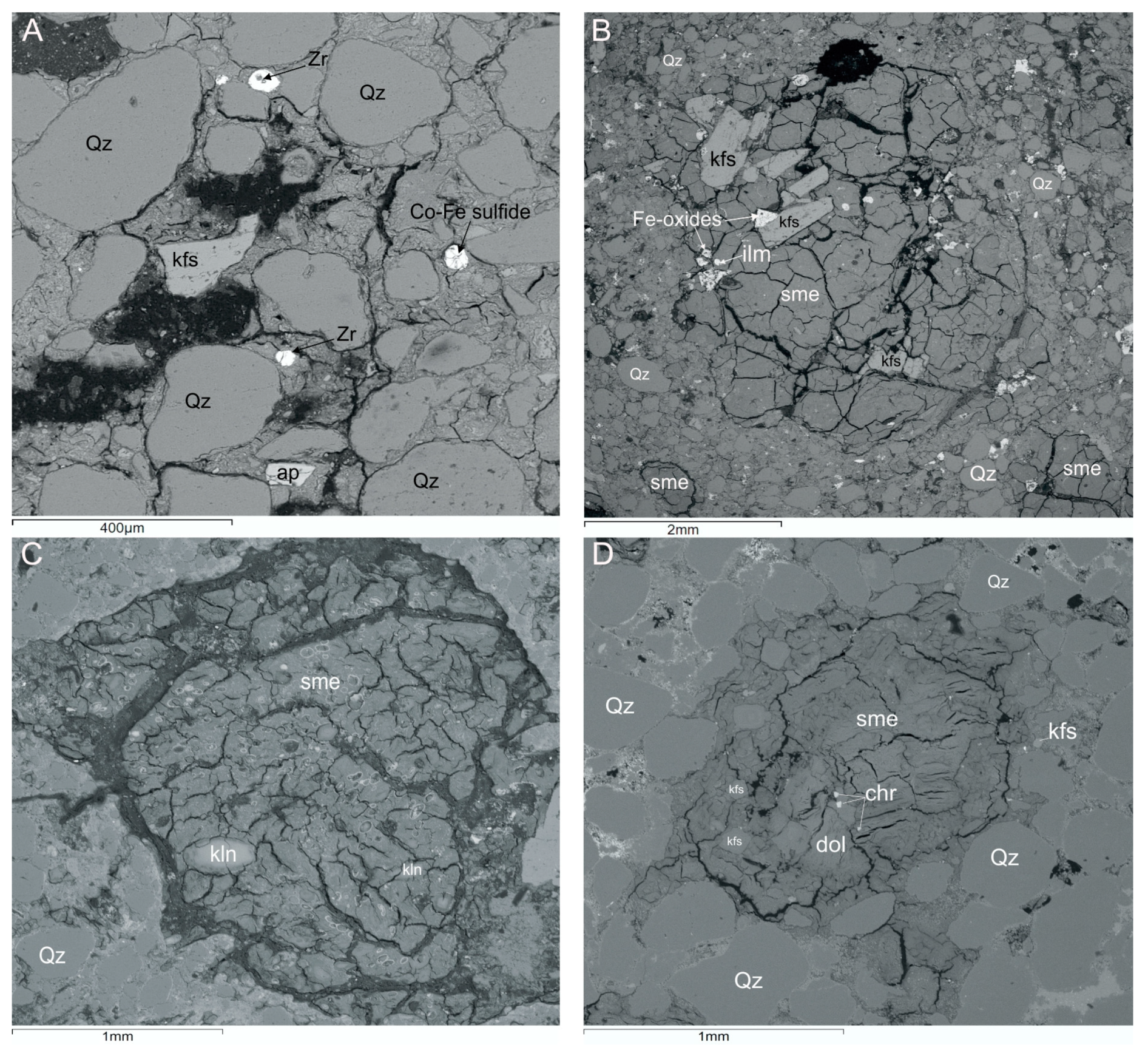
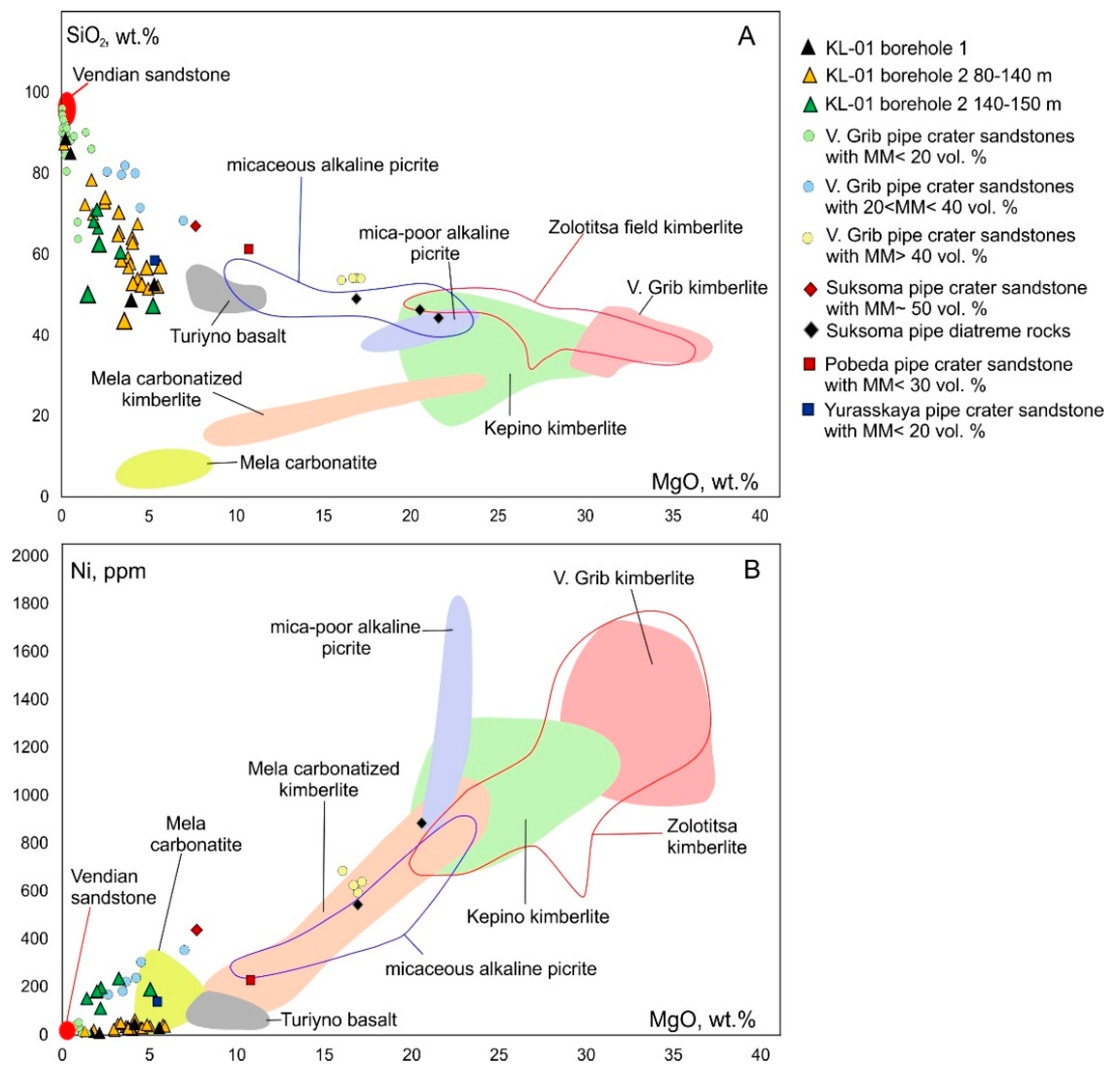


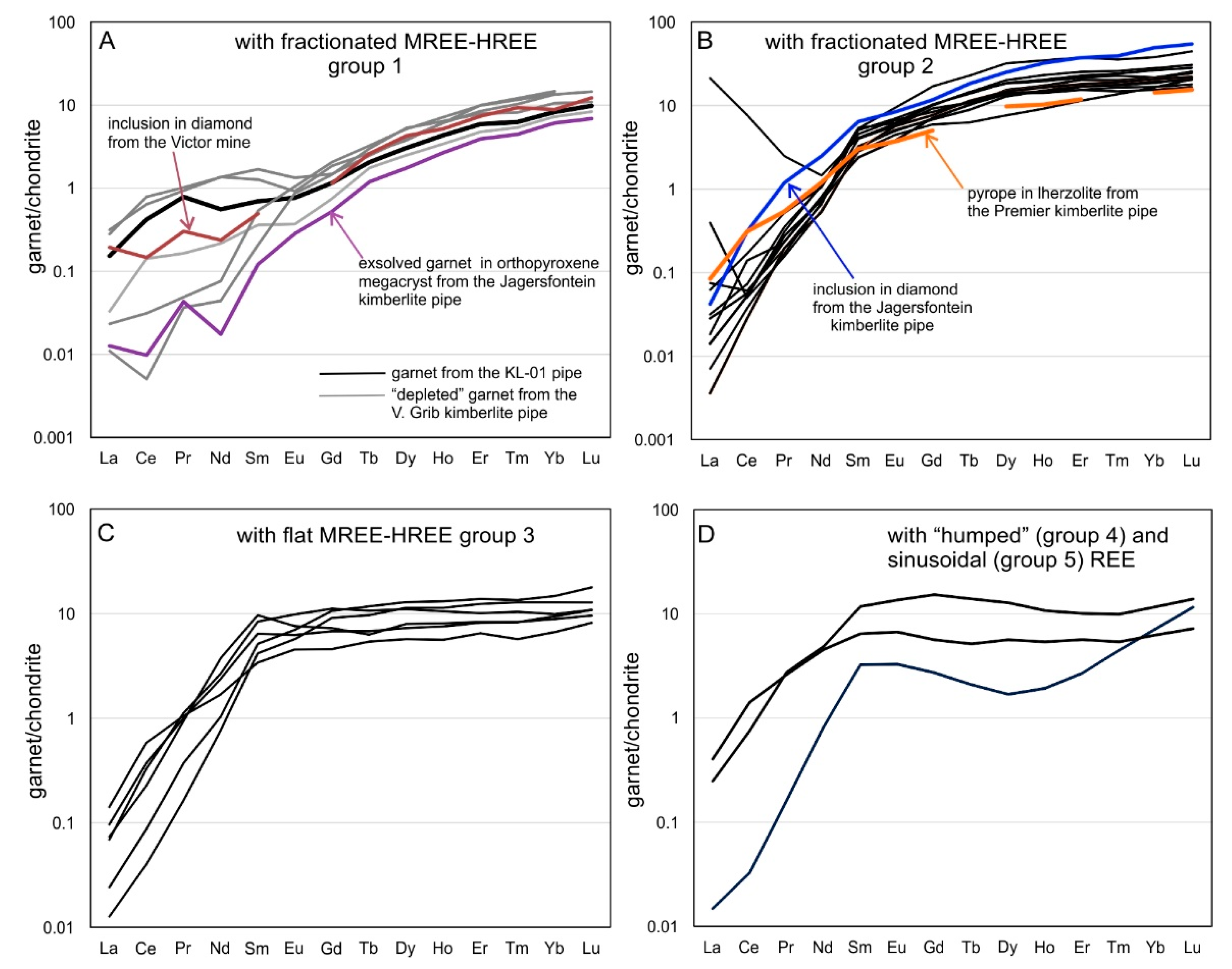


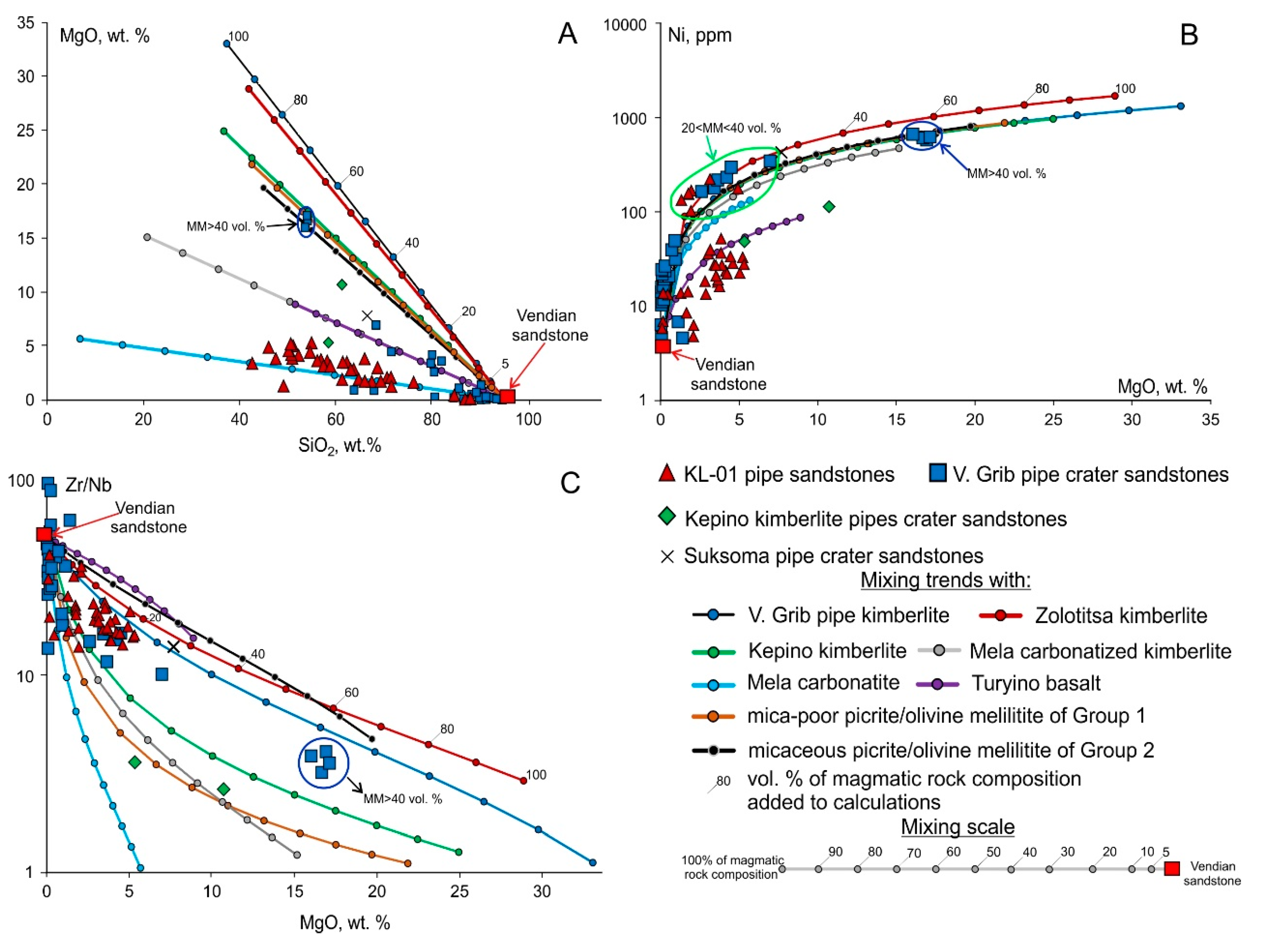

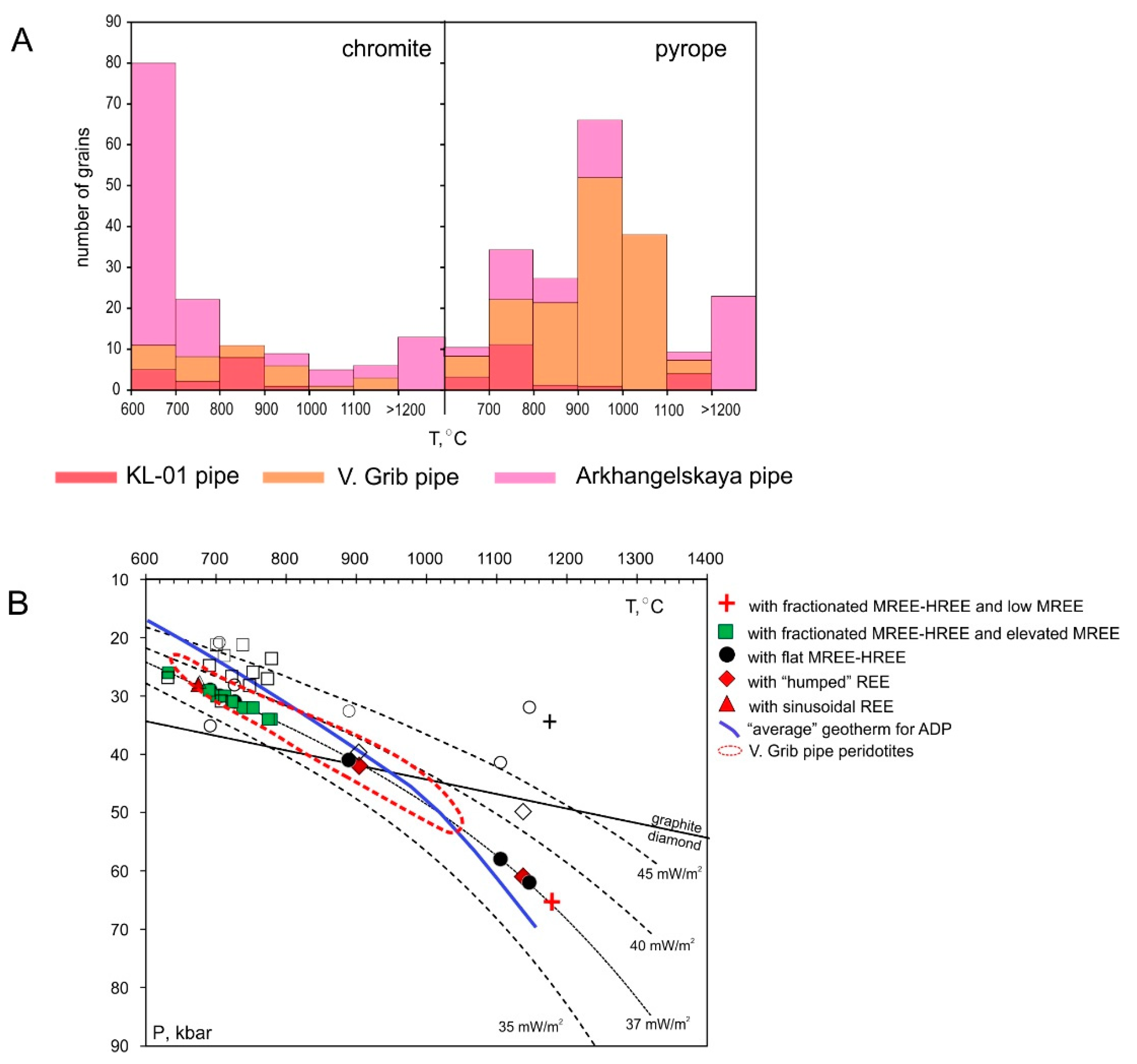
Publisher’s Note: MDPI stays neutral with regard to jurisdictional claims in published maps and institutional affiliations. |
© 2021 by the author. Licensee MDPI, Basel, Switzerland. This article is an open access article distributed under the terms and conditions of the Creative Commons Attribution (CC BY) license (http://creativecommons.org/licenses/by/4.0/).
Share and Cite
Agasheva, E. Magmatic Material in Sandstone Shows Prospects for New Diamond Deposits within the Northern East European Platform. Minerals 2021, 11, 339. https://doi.org/10.3390/min11040339
Agasheva E. Magmatic Material in Sandstone Shows Prospects for New Diamond Deposits within the Northern East European Platform. Minerals. 2021; 11(4):339. https://doi.org/10.3390/min11040339
Chicago/Turabian StyleAgasheva, Elena. 2021. "Magmatic Material in Sandstone Shows Prospects for New Diamond Deposits within the Northern East European Platform" Minerals 11, no. 4: 339. https://doi.org/10.3390/min11040339
APA StyleAgasheva, E. (2021). Magmatic Material in Sandstone Shows Prospects for New Diamond Deposits within the Northern East European Platform. Minerals, 11(4), 339. https://doi.org/10.3390/min11040339




